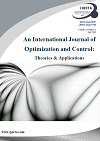Optimizing Human Diet Problem Based on Price and Taste Using Multi-Objective Fuzzy Linear Programming Approach
DOI:
https://doi.org/10.11121/ijocta.01.2012.0095Keywords:
Optimizing human diet, Multi-objective fuzzy linear programming, Triangular fuzzy number.Abstract
Low price and good taste of foods are regarded as two major factors for optimal human nutrition. Due to price fluctuations and taste diversity, these two factors cannot be certainly and determinately evaluated. This problem must be viewed from another perspective because of the uncertainty about the amount of nutrients per unit of foods and also diversity of people’s daily needs to receive them.This paper discusses human diet problem in fuzzy environment. The approach deals with multi-objective fuzzy linear programming problem using a fuzzy programming technique for its solution. By prescribing a diet merely based on crisp data, some ofthe realities are neglected. For the same reason, we dealt with human diet problem through fuzzy approach. Results indicated uncertainty about factors of nutrition diet -including taste and price, amount of nutrients and their intake- would affect diet quality, making the proposed diet more realistic.
Downloads
References
Jana, B., and Roy, T.Kumar, Multi-objective Fuzzy Linear Programming and Application in Transportation Model,Tamsui Oxford Journal of Mathematical Scieces 21(2), 243-268, (2005).
Yeh, C. T., On the minimal solutions of max–min fuzzy relational equations, Fuzzy Sets and Systems159, 23–39, (2008). CrossRef
Tanaka, H., Okuda, T., and Asai, K., On fuzzy mathematical programming, The Journal of Cybernetics, 3, 37-46, (1974). CrossRef
Zimmermann, H. J., Fuzzy set, decision making and expert systems, Kluwer Academic Publisher, (1987). CrossRef
Zimmermann, H. J., Fuzzy set theory and applications, 4rd ed. Kluwer Academic Publisher, (2001). CrossRef
Zimmermann, H. J., Fuzzy programming and linear programming with multiple objective functions, Fuzzy Sets and Systems, 45- 55, (1978). CrossRef
Sakawa, M., and Yano, H., Interactive decision making for multi-objective linear fractional programming problems with fuzzy parameters. Cybernetics Systems 16, 377-394, (1985). CrossRef
Bazaraa, M. S., John J. Jarvis, Hanif Sherali, Linear Programming, A John Wiley & Sons INC., Publication, Third Ed. (1941).
Iskander, M. G., Using the weighted maxmin approach for stochastic fuzzy goal programming, Computer Math. Applic, 154, 543-553, (2006).
Mamat, M., Rokhayati, Y., Mohamad N. N., Mohd, I., Optimizing Human Diet Problem with Fuzzy Price Using Fuzzy Linear Programming Approach, Pakistan Journal of Nutrition 10 (6): 594-598, (2011). CrossRef
Bellman R. E., and Zadeh, L. A., Decision-making in a fuzzy environment, Management Science 17, B141–B164, (1970). CrossRef
Gasimov, R. N., and Yenilmez, K., Solving fuzzy linear programming problems with linear membership functions, Turkish Journal Math. 267, 375–396, (2002).
The Composition of Food: Summary Edition (6 th Edition), McCane and Widdowson's, Great Britain, Food Standard Agency.
Wirsam, B., Hahn, A., Uthus, EO., Leitzmann, C., Fuzzy Sets and Fuzzy Decision Making in Nutrition, European Journal of Clinical Nutrition 51, 286-296, (1997). CrossRef
Raffensperger, J. F., The least-cost low-carbohydrate diet is expensive. Nutr. Res., 28, 6-12, (2008). CrossRef
Downloads
Published
How to Cite
Issue
Section
License
Articles published in IJOCTA are made freely available online immediately upon publication, without subscription barriers to access. All articles published in this journal are licensed under the Creative Commons Attribution 4.0 International License (click here to read the full-text legal code). This broad license was developed to facilitate open access to, and free use of, original works of all types. Applying this standard license to your work will ensure your right to make your work freely and openly available.
Under the Creative Commons Attribution 4.0 International License, authors retain ownership of the copyright for their article, but authors allow anyone to download, reuse, reprint, modify, distribute, and/or copy articles in IJOCTA, so long as the original authors and source are credited.
The readers are free to:
- Share — copy and redistribute the material in any medium or format
- Adapt — remix, transform, and build upon the material
- for any purpose, even commercially.
- The licensor cannot revoke these freedoms as long as you follow the license terms.
under the following terms:
- Attribution — You must give appropriate credit, provide a link to the license, and indicate if changes were made. You may do so in any reasonable manner, but not in any way that suggests the licensor endorses you or your use.
- No additional restrictions — You may not apply legal terms or technological measures that legally restrict others from doing anything the license permits.
 This work is licensed under a Creative Commons Attribution 4.0 International License.
This work is licensed under a Creative Commons Attribution 4.0 International License.












